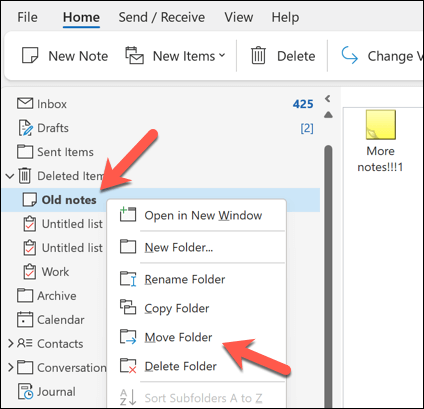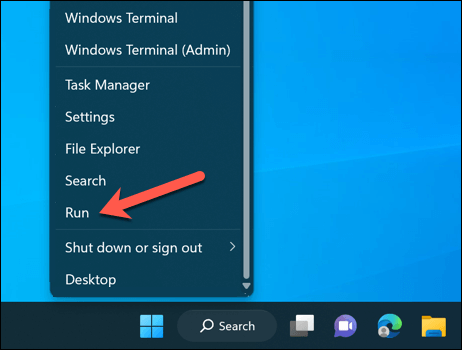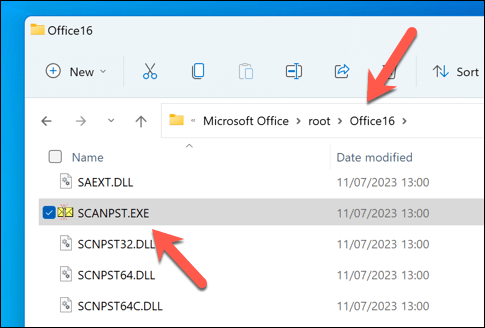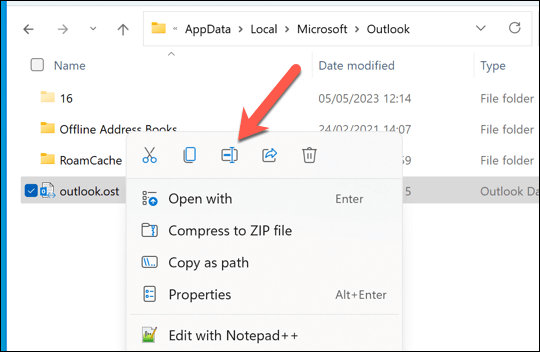So you won't get in trouble with the boss
Outlook isn’t just an application for managing your emails. It’s your productivity hub, with your calendar, contacts, Teams messages, and important notes all accessible—if you can find them, that is. If your Microsoft Outlook notes are missing, you’ll need to figure out why and resolve the problem.
Your Outlook view can be modified (by accident or choice) to hide certain elements, including your Outlook notes. However, you can easily restore your missing notes using a few different methods. To restore your missing Outlook notes, follow the steps below.
1. Reset Your Outlook View Settings
If you’ve recently configured your Outlook view settings, you might have mistakenly hidden certain notes (or all of them) by applying a filter or sort. To check and reset your Outlook view settings, follow these steps.
- Open Outlook and open the Notes folder from the menu bar at the bottom of the side panel on the left.
- In the View tab, select Current View > View Settings.
- Press Filter and make sure that there are no criteria selected that may exclude your notes, then press OK.
- Press Sort and make sure that the sort order is set to Icon or Modified, then press OK.
- Select Group By (if it isn’t grayed out) and make sure that the group by option is set to None, then press OK.
- If the changes still don’t restore your notes, press Reset Current View to restore the Outlook default.
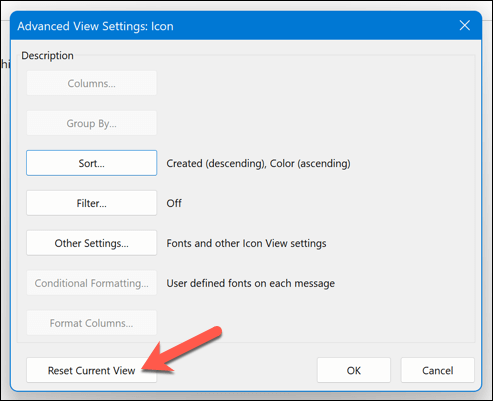
This will reset your Outlook view settings to the default configuration, which should ensure that your notes are visible in the notes folder. You can also use the search function in the notes folder to look through and identify specific notes.
2. Check the Deleted Items Folder
Can’t see your notes? You may have accidentally deleted them. If that’s the case, you’ll need to check whether or not the notes are still accessible in your deleted items folder in Outlook. If they are, you can restore them from there.
To restore your deleted notes in Outlook, follow these steps.
- Open Outlook.
- In the panel on the left, select the Deleted Items folder.
- Search through the list of deleted items. Right-click on the item that you want to recover and select Move Folder.
- Choose the Notes folder and press OK to confirm.
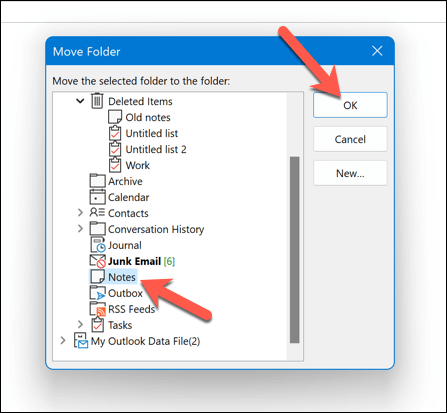
This will restore your deleted notes to their original location.
3. Open Outlook in Safe Mode
If you’re having trouble finding your notes in Outlook, but you think the application itself is at fault, you may need to open Outlook in safe mode. This will disable any add-ins or extensions that could be having an impact on performance (and could cause your notes to disappear).
To open Outlook in safe mode, follow these steps.
- If Outlook is running, make sure to exit it fully.
- Next, right-click the Start menu and select Run.
- In the Run box, type outlook /safe and press OK.
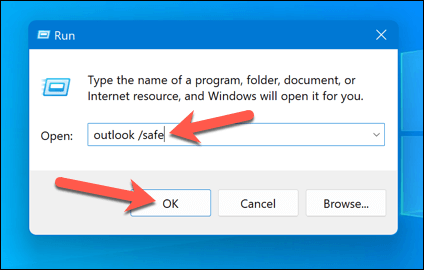
This will launch Outlook in safe mode. With the default configuration visible and no add-ins activated, make sure you can see your notes in the notes folder or in the panel on the left.
If you can, then one of your add-ins or extensions may be causing the problem. Exit Outlook in Safe mode first, then disable the add-ins by selecting File > Options > Add-ins menu and disabling them one-by-one to see if it has an impact.
4. Repair Your Outlook Data File
Your Outlook messages and configuration are typically saved in a profile file using the .pst or .ost format. If your Outlook data file is corrupted or damaged, it will impact what you can see, and could result in you losing your notes.
There’s any number of reasons why the file could be corrupted. A rogue power outage at the wrong time could cause data loss, but don’t discount a malware infection either—make sure to check your PC for malware in the first instance.
Thankfully, you can repair this data file to restore your Outlook profile (and any missing notes). To repair it, follow these steps.
- Exit Outlook and make sure it’s not running in the background.
- Open File Explorer and access a specific folder in your Microsoft Office installation. For Microsoft 365 subscribers, this is C:\Program Files\Microsoft Office\root\Office16. On some devices, you may find it in the C:\Program Files (x86) folder instead.
- Locate the SCANPST.EXE file, right-click it, and select Run as administrator.
- In the Microsoft Outlook Inbox Repair Tool window, press Browse and locate your .pst or .ost file—it’s typically found in the C:\Users\<user>\AppData\Local\Microsoft\Outlook folder. Replace <user> with the name of your user folder. If you’re unsure, you’ll need to search your PC for files with the .pst file extension first.
- Once located, press Start to begin the repair process.
- The repair tool will check your file for errors. If it detects any, it will ask you if you want to save a backup before you repair it. Make sure that the Make backup of scanned file before repairing checkbox is enabled before you press Repair.
- Wait the process to complete, then press OK to complete the process.
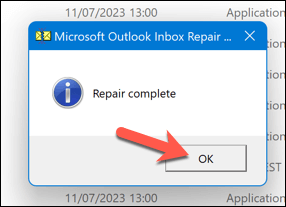
This will repair your Outlook data file and fix any issues with it. You may need to restart your computer after the process is completed. If this doesn’t work, you may need to look at repairing your Office installation.
5. Restore Your Outlook Notes from a Backup
If you have a backup of your Outlook data file, you may be able to restore any missing Outlook notes from it. This can be useful if your notes were deleted or corrupted during an unexpected power outage or hardware failure.
You’ll need a copy of your Outlook data file (in the .pst or .ost format) to be able to proceed.
To restore your Outlook notes from a backup, follow these steps.
- Exit Outlook and double-check that it isn’t running in the background.
- Next, locate your Outlook data file on your computer in the .pst or .ost format. The default location is C:\Users\<user>\AppData\Local\Microsoft\Outlook, replacing <user> with the correct folder name for your user account.
- Right-click the file and select Rename, then rename your current data file to an alternative (eg. if the file is named outlook.ost, rename it to outlook-original.ost).
- Copy the backed up version of the Outlook data file to the same location and rename it to your original filename (eg. outlook.ost).
- Open Outlook and check if your notes are restored.
6. Check for Outlook Updates
No software is free from bugs. If you think a fault in Outlook has caused your notes to disappear, it might be worth checking for any updates in Outlook’s software. If the bug is that serious, it’s quite likely that Microsoft has (or is in the process of) addressing the issue with a new update.
To fix this, you can try updating your Outlook to the latest version and see if that resolves the issue. To update your Outlook version, follow these steps.
- Open Outlook and press File > Office Account.
- Select Update Options > Update Now.
- If there are any updates, Outlook will install them—wait for the update process to complete.
- Once the updates are installed, restart Outlook.
Managing Your Notes in Outlook
Thanks to the steps above, you can quickly restore your Outlook notes if they go missing. You may prefer to use an alternative notes application like Microsoft OneNote. However, to ensure you always have a backed-up version of your notes in the cloud.
Having further trouble with Outlook? If Outlook isn’t responding, you may need to look at more drastic fixes, or consider switching to an Outlook alternative like Gmail instead.







